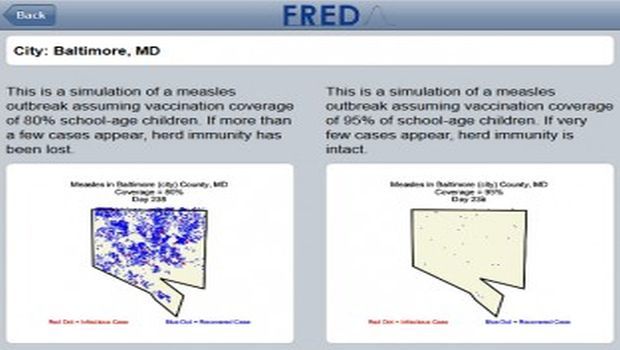Simulating the Potential Spread of Measles
To help the public better understand how measles can spread, a team of infectious disease computer modelers at the University of Pittsburgh has launched a free, mobile-friendly tool that lets users simulate measles outbreaks in cities across the country. The tool is part of the Pitt team’s Framework for Reconstructing Epidemiological Dynamics, or FRED, that it previously developed to simulate flu epidemics. FRED is based on anonymized U.S. census data that captures demographic and geographic distributions of different communities. It also incorporates details about the simulated disease, such as how contagious it is.


A free, mobile-friendly tool called FRED lets users simulate potential measles outbreaks in cities across the country.
To help the public better understand how measles can spread, a team of infectious disease computer modelers at the University of Pittsburgh has launched a free, mobile-friendly tool that lets users simulate measles outbreaks in cities across the country.
The tool is part of the Pitt team’s Framework for Reconstructing Epidemiological Dynamics (FRED), that it previously developed to simulate flu epidemics. FRED is based on anonymized U.S. census data that captures demographic and geographic distributions of different communities. It also incorporates details about the simulated disease, such as how contagious it is.
Try out FRED Measles:
• Go to http://fred.publichealth.pitt.edu/measles/
• Select “Get Started”
• Pick a state and city
• Play both simulations
Both simulations begin with a single case of measles. On the left screen, colored dots representing measles cases quickly cover the area. On the right screen, only a few dots cluster around the initial case. The difference is the vaccination rate: 80 percent (left) vs. 95 percent (right) of school-aged children.
“The visualizations show the importance of a high vaccination rate in providing protection for the entire community,” says Ravi Ravichandran, PhD, of the National Institutes of Health’s National Institute of General Medical Sciences, which partially funded FRED through its Models of Infectious Disease Agent Study (MIDAS).
This concept is called community or “herd” immunity: Immunizing a large segment of a population against a contagious disease reduces the ability of that disease to spread. Last October, the Centers for Disease Control and Prevention published details about vaccination coverage among kindergartners for vaccine-preventable diseases. The coverage for measles varies by state, ranging from 81 to 99 percent.
Planned versions of FRED Measles will allow users to change vaccination rates and also explore the effects of school closures on disease spread.
Pitt’s Donald Burke, MD, who led the development of FRED, says that he hopes this “fact-based tool will help people understand the importance of immunization.”
To learn more about MIDAS, visit http://www.nigms.nih.gov/Research/FeaturedPrograms/MIDAS/.
Source: NIH, National Institute of General Medical Sciences (NIGMS)
Gag Order Puts Public Health at Risk, APIC Urges Immediate Action
February 4th 2025APIC warns that the HHS gag order on CDC communications endangers public health, delaying critical infection updates and weakening outbreak response amid rising tuberculosis, avian flu, Ebola, and measles threats.
Breaking Barriers: The Future of HIV Prevention and the Fight for Widespread PrEP Access
January 31st 2025Despite medical advances, HIV prevention faces roadblocks—low PrEP adoption, stigma, and accessibility issues threaten progress. Experts push for innovative, long-acting solutions to end the epidemic.
The Hidden Dangers of Hospital Ventilation: Are We Spreading Viruses Further?
January 31st 2025New research reveals hospital ventilation and air purifiers may unintentionally spread viral particles, increasing infection risks. Infection preventionists must rethink airflow strategies to protect patients and staff.